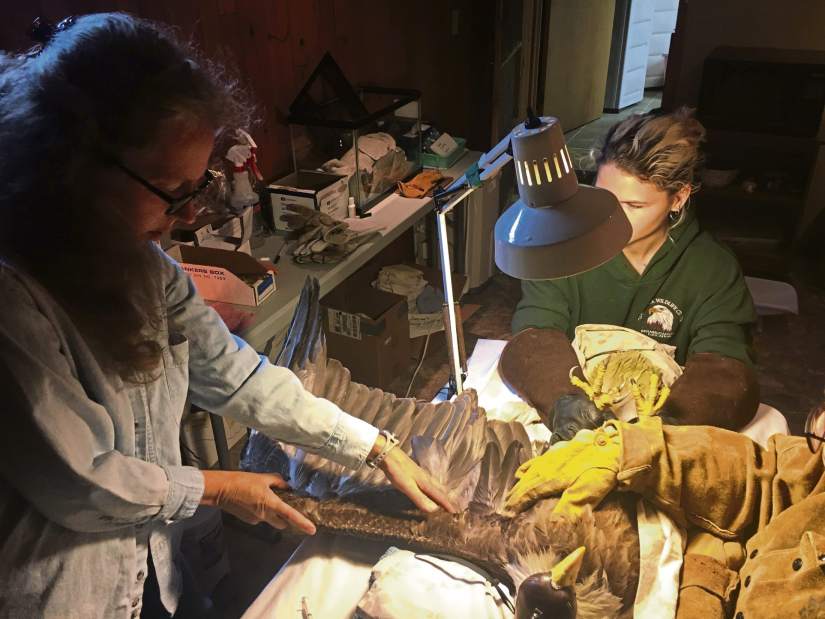Kiski the eagle fights effects of lead poisoning
Kiski the bald eagle is the last survivor out of four that were treated for lead poisoning recently at a Saegertown wildlife clinic.
It was the most the center has had to treat in such a short time span since it was licensed in 1989.
Nicknamed after where he was found, along the Kiski River in Kiski Township, the 30-year-old bald eagle was still hanging on as of Wednesday afternoon, but with a dire prognosis, said Carol Holmgren, executive director of the Tamarack Wildlife Rehabilitation and Education Center.
Lead poisoning is among the leading causes of death for bald eagles in the state, according to the Pennsylvania Game Commission. The game commission has teamed up with New York State to study the causes of the lead poisoning.
Most research points to lead from hunters' ammunition.
While populations of the once-endangered birds have rebounded and continue to increase, some environmentalists have lobbied to ban the use of lead ammunition while others prefer to educate hunters to clean up animal gut piles or change ammunition.
The game commission reports that almost 40 percent of the 29 bald eagles submitted for an animal autopsy in the 2015 and 2016 were diagnosed with lead intoxication, according to Justin Brown, wildlife veterinarian for the game commission's Animal Diagnostic Laboratory.
In New York, state wildlife researchers have documented a growing number of eagle deaths from lead poisoning in recent years, as have wildlife rehabilitators in Minnesota, Oregon, Virginia and other states.
Lead is a leading cause of death for bald eagles, along with being hit by cars, Brown said.
Since the birds eat carrion, they dine on roadkill at their own peril.
When eagles are found with lead poisoning, most times they are either dead or have to be put down.
Elevated lead levels cause blindness, paralysis, lack of appetite and neurological problems that make eagles more likely to fly into buildings or vehicles — if they don't succumb to lead poisoning first.
One tough bird
Kiski's lead poisoning is caused by a metal object in his stomach, something he has eaten recently, Holmgren said.
The center treats bald eagles for lead poisoning typically during deer hunting season and when woodchucks are shot for foraging in crops, usually this time of year.
Tamarack is among only a handful of nonprofits in the state to test for and treat lead poisoning in injured eagles.
A team of veterinarians have been treating Kiski with therapies to remove the critically high levels of lead in his body. But death is common in eagles with such high levels.
“The tragic thing about lead is it can cause a slow, brutal death in vigorous birds that just ate something wrong,” Holmgren said.
Kiski has lived a charmed life so far, residing at the higher end of bald eagle life expectancy.
“He's a grand old man for sure,” said Maryjane Angelo of Skye's Spirit Wildlife Rehabilitation Center in Harrisville, who treated Kiski in 2012 for body bruising and head trauma.
After being released the same year, the bird was rescued again this weekend by Roaring Run Watershed Association officials and the game commission.
They took the bird to the Humane Animal Rescue Wildlife Center in Verona, where they suspected lead poisoning and sent the bird to Tamarack.
“It's sad that something like lead in the environment might take its toll on him,” Angelo said.
“He's made it all these years,” she said, “I'm hoping he can be released for more!”
What to do?
Some want to ban lead ammunition while others prefer hunters voluntarily dispose of animal remains from hunting or change ammunition.
The game commission has not yet made a recommendation, Brown said.
“We want to collect the data and see if it is something we want to manage,” he said. “Potentially, wherever the birds are picking up lead, there might be some way we can mitigate it.”
Hunter education is key, Holmgren said.
“We remain respectful to not vilify hunters,” she said. “They are some of the best advocates for understanding the problem.”
Conversely, the national Humane Society has long sought restrictions on lead ammunition, beyond the 1991 federal ban on lead shot for waterfowl hunting.
California is the first state to ban hunting with lead bullets, phasing out such ammunition by 2019 in favor of less-toxic copper or steel.
Such restrictions are vehemently opposed by the National Rifle Association and other hunting and gun rights organizations.
“Eagles are doing very well, their recovery is a great success story largely supported by excise taxes paid by hunters” on lead ammunition and guns, said Lawrence Keane, senior vice president of the National Shooting Sports Association.
Copper bullets, the main alternative to lead, are more expensive and harder to find than traditional ones. There is also a debate over whether they perform as well.
The Associated Press contributed to this report. Mary Ann Thomas is a Tribune-Review staff writer. Reach her at 724-226-4691, mthomas@tribweb.com or via Twitter @MaThomas_Trib.


